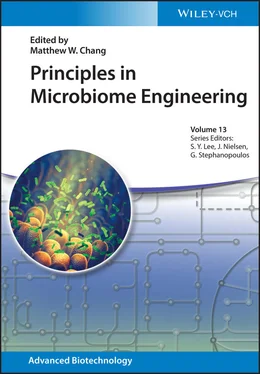Principles in Microbiome Engineering
Здесь есть возможность читать онлайн «Principles in Microbiome Engineering» — ознакомительный отрывок электронной книги совершенно бесплатно, а после прочтения отрывка купить полную версию. В некоторых случаях можно слушать аудио, скачать через торрент в формате fb2 и присутствует краткое содержание. Жанр: unrecognised, на английском языке. Описание произведения, (предисловие) а так же отзывы посетителей доступны на портале библиотеки ЛибКат.
- Название:Principles in Microbiome Engineering
- Автор:
- Жанр:
- Год:неизвестен
- ISBN:нет данных
- Рейтинг книги:5 / 5. Голосов: 1
-
Избранное:Добавить в избранное
- Отзывы:
-
Ваша оценка:
- 100
- 1
- 2
- 3
- 4
- 5
Principles in Microbiome Engineering: краткое содержание, описание и аннотация
Предлагаем к чтению аннотацию, описание, краткое содержание или предисловие (зависит от того, что написал сам автор книги «Principles in Microbiome Engineering»). Если вы не нашли необходимую информацию о книге — напишите в комментариях, мы постараемся отыскать её.
Provides an overview of the techniques and applications insight into the complex composition and interactions of microbiomes Principles in Microbiome Engineering
Principles in Microbiome Engineering
Principles in Microbiome Engineering — читать онлайн ознакомительный отрывок
Ниже представлен текст книги, разбитый по страницам. Система сохранения места последней прочитанной страницы, позволяет с удобством читать онлайн бесплатно книгу «Principles in Microbiome Engineering», без необходимости каждый раз заново искать на чём Вы остановились. Поставьте закладку, и сможете в любой момент перейти на страницу, на которой закончили чтение.
Интервал:
Закладка:
The composition of the intestinal microbiota of people in their golden age (>65 years) differs largely between individuals [132]. These microbiota differ even further compared to the diversity of core microbiota in younger adults [111, 132]. The gut microbiome of elderlies has increased abundance of facultative anaerobes (such as Proteobacteria and Bacilli ) and decreased abundance of F. prauznitzii and Clostridium cluster XIVa bacteria. It was also reported that centenarian's microbiota shows decreased abundance of Bacteroides, Bifidobacterium and Enterobacteriaceae ; and enriched Clostridium spp. abundance [133].
The composition of the microbiota is certainly influenced by age; however, the dietary habits during infancy and pre‐adolescence play an important role in shaping the diversity of the microbiota. The dysbiosis of the microbiota during adulthood alters the host biochemistry, resulting in the changes of the host immune system, behavior, and susceptibility to disease.
1.2.4 Continental Dietary Difference and Its Effect of the Local Microbiome
1.2.4.1 Asia
Dietary habits in Asia are often influenced by rice consumption, which is widely cultivated in Southeast Asia. Other than rice, there is a large diversity of food depending on the agricultural activity within the region [134–136]. While interstate trade supplements domestic production, the main dietary denominator remains in the regional agricultural activities [137]. On top of this, many developing countries in Asia have governmental recommended dietary allowances (RDAs) that also influence eating habits. A study conducted in Zhejiang, China, showed that the mean daily nutrient intake by urban women met the national RDA, meeting the required levels of macronutrients (energy, carbohydrate, protein, and fat). The Chinese government regulates the national food supply to ensure that each state receives foods that meet the nutritional requirements [138].
Additionally, fermented foods that are rich in prebiotics and probiotics are heavily consumed in Asia‐Pacific countries. Such local foods include tempeh, tempoyak (Southeast Asia), natto (Japan), and fermented tea (China and Taiwan); and influence the gut microbiota. Asia‐Pacific children are noted to have higher Bifidobacteria abundance [139], due to supplementary fermented foods in the diet such as Japanese fermented milk products and Korean kimchi [140, 141].
1.2.4.2 Europe
Due to extensive animal‐based husbandry in Europe, tight regulations are enforced to control the release of anthropogenic greenhouse gas emissions (GHGEs) accounting for 25% of total GHGE in Europe [142, 143]. Even so, the main agricultural produce in Europe is red meat and dairy products [144, 145], thus making red meat (processed and unprocessed) and dairy products as part and parcel of the integral diet in Europe. This led to a subtle change in the Western/European microbiome often showed a higher abundance of Prevotella and Bacteroides than Asia‐Pacific microbiome that favors Actinobacteria [146].
1.2.4.3 Australia
The Australian continent agricultural activity focuses on producing wheat, barley, canola, chickpeas, and oats in the winter while producing sorghum grain in the summer. On top of this, other agricultural activities are focused on farming sugarcane, leaving limited farming grounds for orchards and vegetables. This results in lower consumption of fruits and leafy vegetables that are a rich source of prebiotics [147]. Australian diet is also heavily influenced by meat and dairy products [148]. This leads to close to 20% of the adult population being classified as obese as reported by the WHO in 2012 [149, 150]. It is possible that the dietary pattern influenced the increased incidences of Clostridium difficile infection and increased rates of ulcerative colitis (UC) observed in Australia [151]. Additionally, it was found that the dairy‐rich diet in children also influenced enriched Firmicutes ‐affiliated and Bifidobacterium lineages [124].
1.2.4.4 Africa
The geographic location of the African continent results in limited access to proper nutrition among individuals. These are further complicated by years of poverty and geopolitical issues within the continent that prevents agricultural activities in the region. For instance, a study of the populations in the North West Province, Southern Africa, showed barely adequate energy and protein intake and low micronutrient intake among the general population. This includes limited access to green vegetables and fruits that are probiotic‐rich needed to cultivate a healthy microbiome [152]. It was also found that children in Africa showed a lower Firmicutes / Bacteroidetes ratio and low abundance of Enterobacteriaceae ( Shigella and Escherichia ) [153]. The dominant genera of Bacteroides of African children comprise xylan‐ and cellulose‐degrading microbes ( Prevotella and Xylanibacter ) that assist in the digestion of fibrous foods found in tubers like yam and sweet potatoes that are present in the rural African children diet.
1.2.4.5 South America
South America adopts a wide variety of dietary patterns. The primary source of polysaccharide in South American diet includes wheat, corn, rice, and tubers. Yucca and bananas are also part of the daily diet in most Latin American countries. Access to a sugar‐rich diet, and low administrative tax on sugar‐sweetened products resulted in quicker absorption of energetics in the human body [154]. This impacts pre‐adolescents and teenagers, in particular, who were in Latin America have shown an estimated overweight prevalence of approximately 7% in children younger than 5 years. This is further complicated by the high intake of cookies, dairy products, and fruit juices [155, 156].
1.2.4.6 North America
Similar to certain Asian diets, the dietary habit of North Americans is regulated by public health policies [157]. Based on this, the Diet Quality Index was used in evaluating trends of the US population and found significant improvements from 1965 to 1991 [158]. This is further promoted by the Alternate Healthy Eating Index 2010 [159]. It was found that North Americans have a border range of dietary factors, broad macronutrients, multiple food sources, and nutrients [160]. It was shown that US adults consumed more grains from a study conducted from 1999 to 2012, with a stable intake of unprocessed red meat and poultry consumption. Despite the access to a large variety of foods, it was found that the US adults have the least diverse fecal microbiota, showing an abundance of 23 groups (an average non‐US adult have 73 groups) with the major constituent in the Prevotella genus [161].
1.3 Dietary Modulation of Microbiome for Disease Treatment
In sub chapter 1.2, the role of dietary habits and the nutritional composition evidently play a role in both short‐term regulation of the microbiome and long‐term shaping of the microbiota landscape [54, 96, 162]. The microbiome changes facilitate various health‐benefiting properties to the host, such as regulating the host immune system, perturbing host growth, and development, altering the host biochemistry and affecting the microbiome in other parts of the human host [163, 164]. It is often unclear whether it is the change of the host biochemistry that perturbs the microbiota population or the changes of the microbiota population that alters the host biochemistry ( Figure 1.4). However, certainly these changes can positively influence the hosts' health by boosting the immune system or negatively impacting the host through dysbiosis, resulting in the pathogenesis of various diseases. Through shaping the host's dietary pattern, it is possible to encourage the growth of the desired microbiota population through the use of prebiotics and nutrients or to eliminate antagonistic competitors of the health‐conferring commensals using probiotics.
Читать дальшеИнтервал:
Закладка:
Похожие книги на «Principles in Microbiome Engineering»
Представляем Вашему вниманию похожие книги на «Principles in Microbiome Engineering» списком для выбора. Мы отобрали схожую по названию и смыслу литературу в надежде предоставить читателям больше вариантов отыскать новые, интересные, ещё непрочитанные произведения.
Обсуждение, отзывы о книге «Principles in Microbiome Engineering» и просто собственные мнения читателей. Оставьте ваши комментарии, напишите, что Вы думаете о произведении, его смысле или главных героях. Укажите что конкретно понравилось, а что нет, и почему Вы так считаете.












